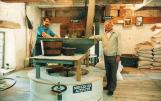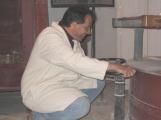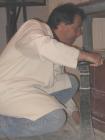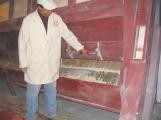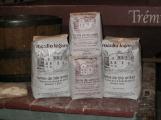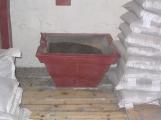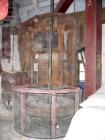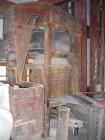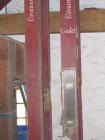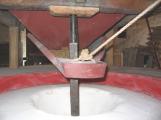1
The miller's workThe miller's work is divided into four categories: first, he operates the mill; next, he maintains and repairs the machines, gears and belts; then, he carries out the tasks known as commercial tasks; and finally, he assumes the role of host.
In order to operate the mill, the miller must first make sure that the water power is functioning normally. He must ensure that the water door to the mill is not jammed; all the branches and garbage carried away by the current must be removed so that they do not come into contact with the turbines and break them.
The miller must also check the millstones in order to ensure the high quality of the ground flour and to see that grain is constantly pouring into the hopper placed above the millstones. At the same time, he must regularly gather the bran at the time of the screening, while also gathering the wheat from the bolter, which is falling into a large bin.
In order to maintain and repair the mill, the miller uses the same materials that have always been used. Thus, he uses leather to repair or change the elevator bands and the belts that run on some of the gears.
The tasks known as ?commercial? tasks include the following: the miller must prepare client orders, which means that he must undertake the bagging and labelling of the flour, and then must deliver it. Inside the mill, the miller welcomes clients and sells flour and bran.
Assisted by interpreter-guides during the summer season, the miller welcomes visitors and is always pleased to explain to them how the mill operates, and the use of time-honoured flour production methods.
9
Making flourOnce the mill is in operation, the first step that the miller must undertake consists of opening a pocket of grain and pouring it into the initial hopper, beside the grain elevators. By pulling on a wooden lever, the miller allows the grain to descend to the first basement where it gradually flows into buckets attached to an elevator.
The grain is first transported into a grain cleaner, a machine that is more than one hundred years old, where it is separated from the bits of straw and all other impurities. From there, the grain returns by means of another elevator to a hopper located in the mill's attic, where the miller sends the grain through a chute, onto the hopper placed just above the millstones.
The following step concerns the actual making of the flour. An opening in the hopper allows the grain to flow toward the trough, a piece of wood made for collecting the grain; when the mechanism makes the millstone rotate, the central square shaft, called the vertical shaft, hits the trough at regular intervals, causing the grain to fall down through the centre of the runner stone. The grain is crushed toward the centre of the bedstone and the grooves, traced when the millstones are sharpened or ?picked,? bring the flour out to the edges of the millstones.
After it has been ground, the flour must pass through the screening step in order for the elements of the grain to be separated. Another elevator mechanism allows the flour to pass under the millstones and reach the inside of the bolter. The bolter is a large wooden roller, whose circumference is covered in silk, called the bolter's weaving, of which the screening extends from small to large, and which allows the wheat, starch, gluten, wheat germ and shorts, the elements of the wheat, to be separated. The leaf sheath of the wheat, called the bran, falls into a pocket at the end of the bolter.
